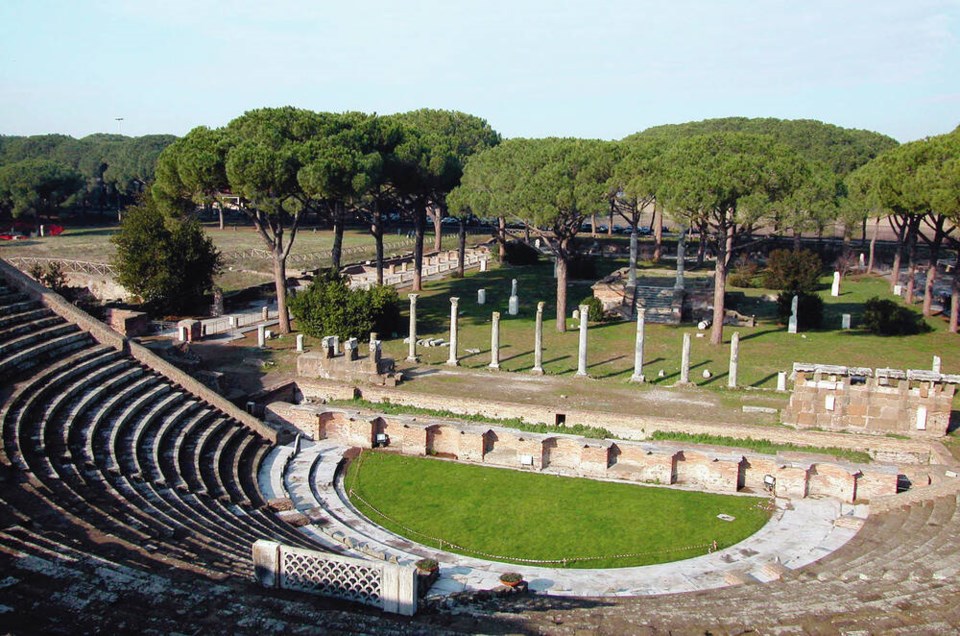Sitting on the top row of the ancient arena, I scan the ruins of Ostia, letting my imagination take me back 2,000 years to the days when this was ancient Rome’s seaport, a thriving commercial centre of 60,00 people. I marvel also at how few visitors make the simple 20-mile trip from downtown Rome to what I consider the most underappreciated sight in all of Italy.
Ostia Antica, a 45-minute Metro/commuter-train ride away from Rome, offers ancient thrills to rival Pompeii (which is four hours south of Rome). Wandering around the ruins today, you can see the remains of the docks, warehouses, apartment flats, mansions, shopping arcades, and baths — all giving a peek at Roman lifestyles.
Ostia, at the mouth (ostium) of the Tiber River, was founded around 620 BC; its central attraction was the salt gleaned from nearby salt flats, which served as a precious meat preserver. Later, around 400 BC, Rome conquered Ostia and made it a naval base, complete with a fort. By AD 150, when Rome controlled all the Mediterranean, Ostia served as its busy commercial port.
With the fall of Rome, the port was abandoned. Over time the harbour silted up. I’d like to take a moment to thank the mud that eventually buried Ostia, protecting it from the ravages of time — and from stone-scavenging medieval peasants.
Ostia’s small museum offers a delightful look at some of the city’s finest statuary — tangled wrestlers, kissing cupids, playful gods. Most of the statues are second- and third-century AD Roman pieces inspired by rare and famous Greek originals. But the portrait busts here are of real people — the kind you’d sit next to in the baths (or at the famously many-seated public toilets). Roman religion revered the man of the house (and his father and grandfather). As statues of daddy and grandpa were common in the corner of any proper house, many survive today.
Surviving frescos, while scant and humble, give a feeling for how living quarters may have been “wallpapered.” Perhaps the museum’s most interesting room features statuary from religions of foreign lands. Being a port town, Ostia accommodated people, and their worship needs, from all over the known world.
These days, you can stroll among the ruins and trace the grid standard for Roman military towns: a rectangular fort with east, west, north, and south gates and two main roads converging on the Forum. Walking along the main drag, you can identify buildings from the Republic (centuries before Christ) and the Empire (centuries after Christ) by their level. Over the centuries, Ostia’s ground level rose, and the road was elevated. Anything you walk down into is BC.
Also on the main drag is Ostia’s vast theatre, one of the oldest brick theatres anywhere — and it’s still used for concerts today. Three rows of marble steps near the orchestra still stand out; they used to be for big shots.
Just in front of the theatre is the grand Square of the Guilds, the former bustling centre of Rome’s import/export industry, with more than 60 offices of ship owners and traders. Along its sidewalk, second-century AD mosaics advertise the services offered by the various shops — a lighthouse symbolizes the port of Ostia and an elephant marks the office of traders from Africa. It’s fun to walk the entire square guessing from the ancient signs what was once for sale behind each storefront.
The Forum Baths, a huge, government-subsidized complex, were the city’s social nerve centre. Fine marble steps — great for lounging — led to the pools. People used olive oil rather than soap to wash, so the water needed to be periodically skimmed by servants. From the viewpoint overlooking the Baths of Neptune you can see a fine mosaic of Neptune riding four horses through roller-coaster waves.
A structure called the House of Diana is a great example of insulae — multi-storied tenement complexes where the lower-middle class lived. Nearby is the Insula of the Thermopolium, a tavern where, if you belly up to its bar, you can see a small sink, shelves once used to display food and drinks for sale, and scant remains of wall paintings.
A meander down Ostia’s back lanes is a veritable archaeological scavenger hunt. If you visit, keep your eyes peeled for hidden bits of fresco, preserved mosaic flooring, and millstones for grinding grain back when business was booming.
The key to enjoying sights from ancient Rome is to resurrect all that rubble in your mind. A quick trip out to Rome’s ancient port helps do just that, making it more likely that your hours climbing through the wonders of ancient Rome will give you goose bumps rather than heatstroke.
Rick Steves () writes European guidebooks, hosts travel shows on public TV and radio, and organizes European tours. You can email Rick at [email protected] and follow his blog on Facebook.



